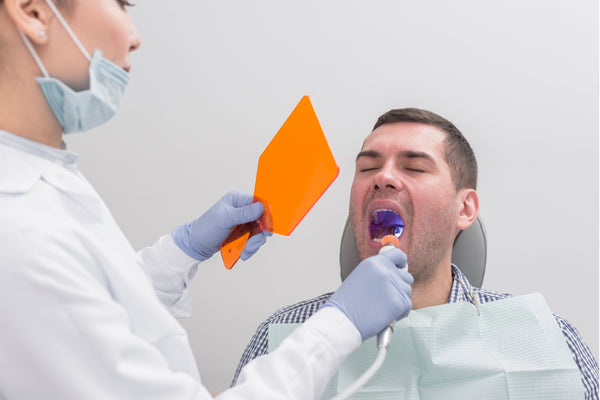
How To Remove Dental Cement From Crown?
Introduction
Dental crowns are necessary to fix the function and appearance of teeth that are broken or rotted. Dental cement is often used to hold them in place. This makes sure that the crown and tooth are strongly attached. But there are times when the toothpaste needs to be taken off. This might be needed when a crown needs to be fixed or replaced, moved, or when temporary crowns need to be removed. Understanding why dental cement must be removed is very important for keeping your dental work in good shape and ensuring it lasts as long as possible.
This blog aims to give you information on how to take dental cement off a crown safely when needed. We know that dealing with your dental work can be scary, but if you have the correct information and help, you can do it without any problems. Whether you're a dentist who needs to brush up on your knowledge or a customer who wants to know more about what happens during a crown removal, this blog is meant to be your one-stop shop for everything you need to have a smooth and successful experience. So, let's learn how to remove plastic from a crown quickly and easily.
Importance of understanding the process
Taking dental cement off of a crown needs to be done carefully and precisely. If you rush into the process without knowing it, you could face problems and damage the crown or even the tooth structure underneath. Because of this, it's essential to stress the importance of understanding the process before removing dental cement.
Preserving the Crown: Crowns for teeth are made to be strong and last long. But if you don't remove the cement correctly, the crown could get chips, cracks, or even break. Knowing how the process works, you can take the proper steps to keep the crown in good shape.
Minimizing Discomfort: If you don't do it right, removing tooth cement can be painful for the patient. Understanding the process makes the treatment go more smoothly and with less pain for the person going through it.
Preventing Damage to Natural Teeth: In some cases, removing dental cement may involve regular teeth that are close by. If you need to understand the process thoroughly, you might accidentally hurt these teeth, which could cause more dental problems.

Ensuring Successful Reattachment: If you desire to reattach the crown after removing the old cement, learning how to do it will ensure that the bond between the crown and the tooth is durable and strong. For this step, you must clean and get ready properly.
Avoiding Emergency Situations: If you're not careful, removing dental cement can cause an emergency, like a crown coming loose or a lot of pain. Understanding the process makes it less likely that something like this will happen.
Safeguarding Oral Health: Overall, knowing how to get rid of dental cement helps keep your teeth healthy. It ensures the process is done right, lowering the chance of problems and the need for more dental work.
It's worth noting that while understanding the process is essential, it's equally crucial to consult with a dental professional for guidance and assistance. They have the expertise and experience to perform these procedures safely and effectively. Suppose you need help with how to remove dental cement from a crown. In that case, it's always best to seek professional dental care to avoid any potential issues and ensure the best possible outcome.
Reasons for Crown Cement Removal
Situations requiring cement removal
There are a few reasons dental cement might need to be removed from a dental crown. Often, a tooth crown needs to be fixed or replaced. After all, it is worn out, broken, or doesn't fit right. In this case, the old cement must be carefully removed so that the crown can be accessed and any repairs or replacements can be made. Also, removing the cement is essential if you need to move a crown or remove a temporary crown that has done its job. Understanding the specific situations where you must remove cement is essential to keep your dental work in great shape.
Effects of residual cement on oral health
If you leave cement under a dental crown for too long, it can hurt your mouth health. It can make spaces in your teeth where germs can grow, which could cause gum swelling, pain, or even an infection. If you don't fix it, it can lead to pain, bad breath, and more major tooth problems. So, removing the extra cement is essential for keeping your teeth clean and avoiding problems. This blog post will talk about why it's essential to remove cement completely and walk you through the steps to help you protect your mouth health.
Preparing for Cement Removal
Tools and materials needed
Before you take dental cementing off of a crown, you must ensure you have all the necessary tools and materials. These include protected gear like gloves and safety glasses, as well as dental tools like scalers and pliers made to remove cement. Ensuring you have the right tools is essential to ensure the process goes smoothly and safely. In this part, we'll talk about the most essential tools and supplies you'll need to remove cement.

Importance of patient comfort
It is essential to ensure the patient is comfortable while the cement is removed. Pain and worry can complicate things for the patient and the dentist during the process. Because of this, minimizing any pain or discomfort that might come with the removal process is essential. In the next few posts, we'll discuss different ways to keep the patient calm and relaxed during the process, which will lead to a better, less stressful experience.
Ensuring a clean and sanitized workspace
Keeping the work area clean and germ-free is essential to any dental treatment, even removing the cement from a crown. To keep infections and pollution to a minimum, it is essential to keep the area clean. In the next part, we'll talk about how important it is to keep your dentist's office or home desk clean. In addition, we will give you helpful advice on ensuring the area is clean and ready for the cement cleaning process. Ensuring the area is clean and safe is very important for the success of the cleaning process and the patient's general tooth health.
Step-by-Step Guide to Removing Dental Cement
Removing dental cement for crowns requires precision and patience. Whether you're a dental professional or attempting this at home, follow these steps carefully to ensure a successful procedure:
Step 1: Prepare Your Workspace
- Begin by assembling all the necessary tools and materials, including a dental mirror, dental explorer or scaler, dental floss or orthodontic bands, and adequate lighting. Ensure your workspace is well-lit and you wear protective gear, such as safety glasses.
Step 2: Prepare the Patient
- If you're performing this procedure on a patient, ensure they are comfortable in the dental chair with their mouth open wide enough to access the crown. Consider using a topical anesthetic gel if needed to numb the area and minimize discomfort.
Step 3: Isolate the Tooth
- Use a dental dam or cotton rolls to isolate the tooth with the crown. This helps keep the area dry and prevents debris from interfering with the procedure.
Step 4: Examine the Crown
- Carefully examine the crown to determine the type of cement used and whether there are any visible signs of loose or damaged cement. This information will guide your removal process.
Step 5: Begin Cement Removal
- Start by using the dental explorer or scaler to gently locate the edge of the cement around the crown's perimeter.
- Use the dental mirror to maintain a clear view of the area as you work.
Step 6: Gradually Loosen the Crown
- Insert the dental scaler or explorer under the crown's edge and gently and slowly work your way around, loosening the cement.
- Be patient and take your time to avoid damaging the crown or the tooth beneath.
Step 7: Remove the Crown
- Carefully lift the crown off the tooth once you've sufficiently loosened the cement. Use dental floss or orthodontic bands to thread gently between the crown and the tooth if needed.
- Ensure you maintain a firm grip on the crown to prevent it from falling or getting damaged.
Step 8: Clean the Crown
- With the crown removed, clean off any remaining cement residue using a dental scaler or other appropriate tools.
- Inspect the crown for any damage or signs of wear.
Step 9: Prepare for Reattachment (If Applicable)
- If the intention is to reattach the crown, consult with the patient about the next steps.
- Ensure the crown is appropriately cleaned and ready for re-cementation.
Step 10: Post-Procedure Care
- Provide post-procedure instructions to the patient, including any necessary precautions or care recommendations.
Step 11: Consult a Dental Professional (If Needed)
- If you encounter any difficulties during the removal process or if the crown removal is part of a more complex dental treatment, it's advisable to consult with a dental professional for guidance and assistance.
Following these step-by-step instructions, you can safely and effectively remove dental cement from a crown. Remember that patience and precision are key to ensuring a successful procedure and preserving the integrity of the crown and underlying tooth structure.

Post-Removal Care and Recommendations
Once the dental crown cement has been removed from a crown, it is essential to give the patient clear, practical instructions on caring for their mouth health. One of these is advice on keeping your mouth clean and healthy by using the right dental products and methods and following good oral hygiene habits like brushing and flossing every day. Patients should be told about habits and practices that can help their dental crowns last longer and make it less likely that they will need cement removed often. Stick to healthy eating habits and get regular oral check-ups. Don't chew on hard things. As long as people care for their teeth, their dental work will last longer, and they will need fewer repairs.
Conclusion
After reading this, taking dental cement off a crown might seem complicated, but it can be done quickly and safely if you know what you're doing. You have been given a complete plan that includes all the necessary steps, safety precautions, and things to consider to remove the cement successfully. The first step in this process is to learn why crown cement is being removed and what effects it might still have on your mouth health. Our step-by-step guide has full steps on safely removing cement, with extra tips for temporary and permanent crowns. Additionally, we've discussed possible problems that might arise during the process, giving you the information you need to handle them effectively.
We hope this blog has given you the knowledge and courage to remove dental cement quickly and skillfully. Remember that it's always best to talk to a trained dentistry professional when figuring out what to do or when things get tricky. Protecting your oral health takes work from everyone, but if you know what to do and take the proper steps, you can keep your beautiful smile for years. If you need dental instruments, visit Dental Finds and get reasonably priced products.

